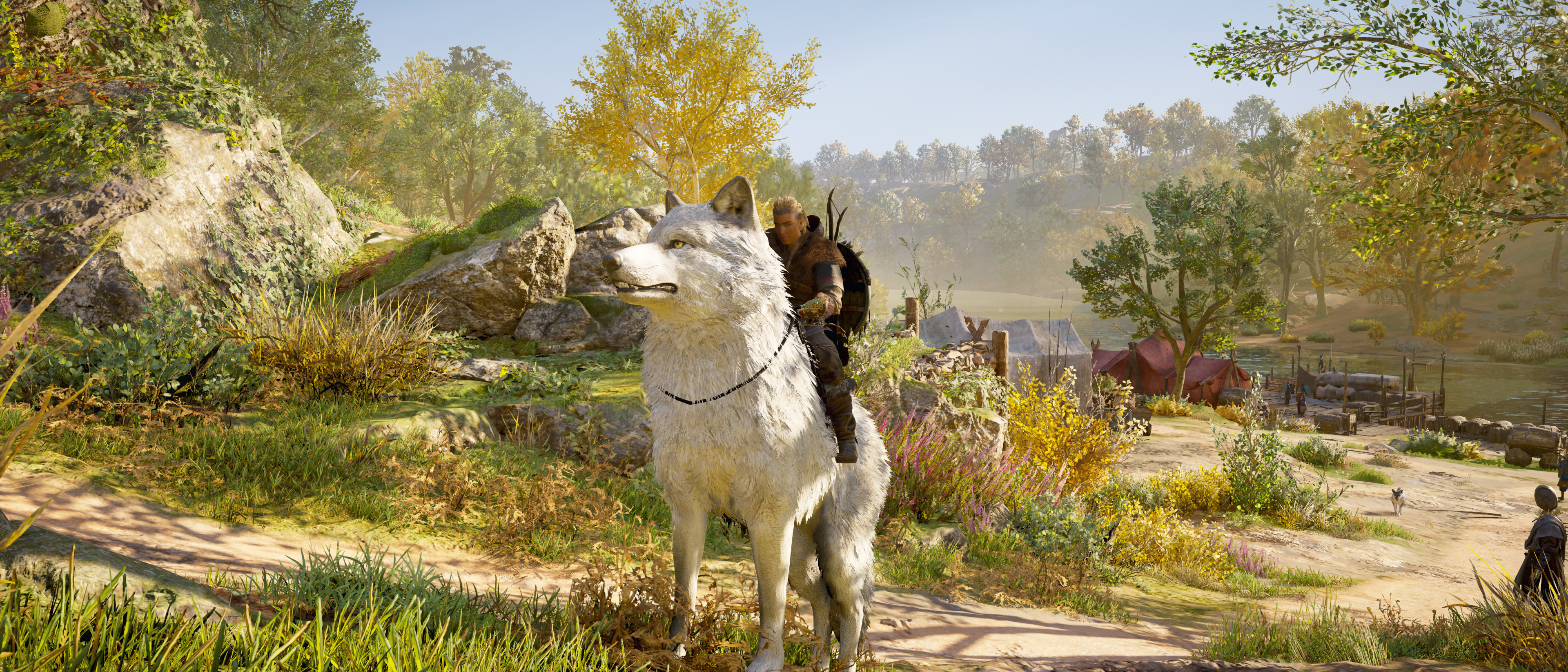Laptop Mag Verdict
Assassin’s Creed Valhalla has a number of issues and janky moments, but its impressive exploration and gorgeous world-design are too immersive to pass up.
Pros
- +
Solid gear system
- +
Fun combat and stealth mechanics
- +
Immersive incentivized exploration
- +
Gorgeous world-design
Cons
- -
Skill tree is bloated
- -
Parrying is janky
- -
Dated character models
Why you can trust Laptop Mag
Assassin's Creed Valhalla is my first AC game since Unity, so I didn't get to experience the RPG transformation that took place in Origins. I've only dabbled in Odyssey, so I really didn't know what to expect with Valhalla. The pessimist in me thought I would find a bloated, aimless open-world action RPG, but what I actually found was something more carefully crafted.
Don’t get me wrong, Valhalla has its fair share of issues, and it doesn’t really keep up with other big action-adventure RPGs currently out there now or launching soon. However, the moment that Assassin's Creed Valhalla clicked with me was when I roamed the lively snowy peaks tops of Norway and randomly encountered the Elk of Bloody Peaks only to go axe-to-antler with it at the edge of a glowing pool of water on a mountaintop. It was immersive and magical.
Between its fun combat and stealth mechanics, immersive exploration and gorgeous world design, Assassin's Creed Valhalla is a great game if you find it on sale. At a lower price, I could see Valhalla being one of the best PC games to play.
The road to Valhalla is paved in dry acting
Apart from some light researching, I knew absolutely nothing about the present day story in Assassin’s Creed Valhalla before going in so imagine my satisfaction when the game didn’t open with the present day narrative. This particular Assassin’s Creed arc started in Origins and continued in Odyssey, so Valhalla is technically the third in this narrative.
However, the Viking storyline is rather easy to follow. We take control of Eivor, a male or female Viking, who follows their brother Sigurd and the rest of the Raven clan to England in order to build a new home and rebuild the strength of the faction.
From what I’ve played, the story is interesting and I find myself invested in its characters. But what occasionally kills the game is the stale acting from not only the supporting characters, but also the protagonist. I’m currently playing as female Eivor, but since I can freely go from male and female or even have both (the Animus will pick the one best for the situation), I’ve been switching on and off. Female Eivor didn't have the best first impression but she is growing on me. From what I’ve played of male Eivor, his voice fits his character nicely, but I’ll likely continue my playthrough with the female version.
Assassin’s Creed Valhalla is also the first game I’ve ever played that actually mentions COVID-19. In an email to the present-day protagonist, Layla Hassan, one of her family members was worried about Layla getting COVID. Layla responded and assured them that she was taking the proper precautions and isolating herself. In a fictional world that’s literally on fire, there’s still COVID-19. It couldn’t be more depressing. But I’m glad this detail is in the game because the virus is a very real threat, and it shouldn’t be washed away from history.
Thrilling Viking combat has its janky moments
Assassin's Creed Valhalla feels like a marriage between Dark Souls and Ghost of Tsushima with a sprinkle of God of War side-action, but it doesn't have a firm understanding on why those games worked so well.
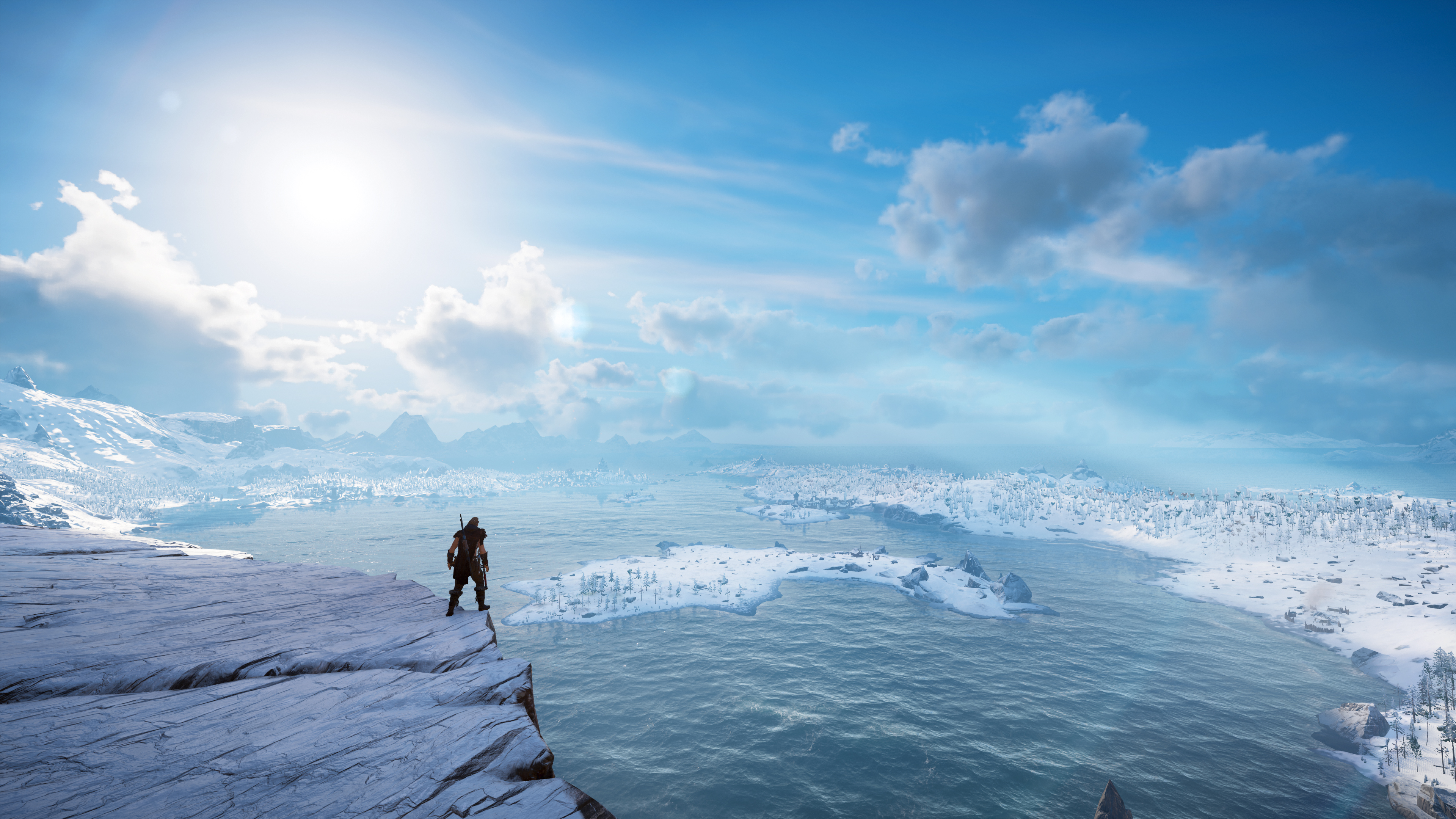
Let me start by saying that Valhalla’s combat is fun. Lodging my viking axe into someone's neck, rolling out of the way of an unseen attacker, then parrying him and finishing him off with his own sword is incredibly satisfying.
Unlike Dark Souls, Valhalla wants the player to fight aggressively, which suits the Viking tactics. It encourages offense with stamina. Light attacks earn stamina whereas dodging, blocking and missing attacks waste stamina. Stamina is also used by landing heavy attacks, which are great for knocking opponents down and breaking shields.
However, in true Ubisoft fashion, the combat is a bit janky. The indicators for parriable and unblockable attacks are either too fast or too slow, and rarely on time. I either parry early and get smacked in the face or get a 0.1-second warning before a heavy attack bodies me.
Adding to that, I can't parry an enemy unless they're directly in front of me. This rule is perfectly OK in games like Dark Souls, but this doesn't work for Valhalla because the movement is sluggish in combat. I have to rely on dodging out of the way for attacks coming from behind. The dodge doesn’t get me very far, so typically I dodge twice, and it wastes quite a bit of energy, which is an issue because it leaves me in a position where I'm low or out of stamina. And to top it off, if my weapon is deflected by a shield or a weapon, I’m stuck in one of the longest, useless combat animations unless I dodge.
When I'm fighting one or two enemies, the flow of combat still feels good considering the limitations, but once Eivor starts raiding and fighting against small armies, the flow is broken. If I can't parry enemies behind me, I need to be constantly on the move keeping enemies in front of me. That’s challenging because the base movement doesn’t feel good and I can only dodge so often.
Despite that, the flow of being a Viking Assassin is actually fantastic. I’ve seen the complaints about not being able to assassinate enemies instantly in previous games, but that isn’t an issue in this game. There’s a skill tree in Valhalla, which I’ll talk more about later, but the gist is that Eivor can take out just about any enemy with an assassinate attack as long as it’s timed right. There will be a button prompt, and you have to hit the button when the lines match. It’s not too difficult, and I think it’s a creative way to make it more challenging to take out vigilant fighters.
Additionally, where Valhalla gets stealth combat right is its detection mechanics. I’m playing on the hardest difficulty, but even if I get detected by one guard, I can have a whole combat session with them and not alert the other guards. Each enemy has their own alertness, which is genuinely amazing because it makes stealth much more manageable.
The one issue I found that can make stealth combat a bit frustrating is the bow. Even when I’m hiding in a bush, if I take my bow out and aim at a guard, they can spot me, which is annoying. You could argue that if that wasn’t the case, then I could snipe everyone with a bow. But in Ghost of Tsushima, you could aim and fire your arrows without anyone noticing, and that worked perfectly well because enemies would eventually know where the arrows were coming from.
The RPG elements that make up Valhalla
One of the biggest leaps for the Assassin’s Creed series was giving players access to a skills tree and upgradable gear. In Valhalla, these elements can be both fun and frustrating to work with.
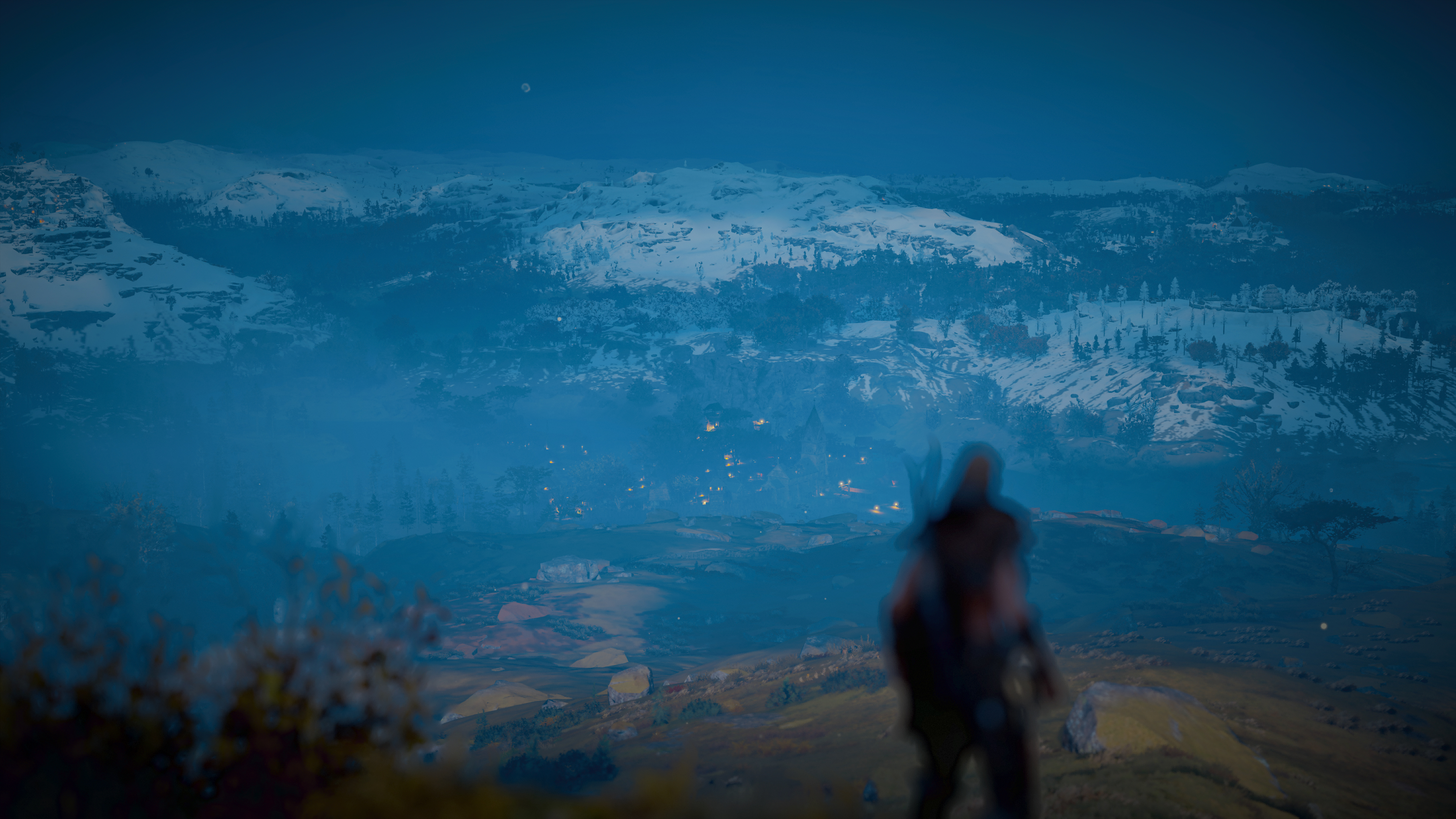
Let’s talk about the skill tree and why it doesn’t really work. To give you an idea, there are three major paths that are all interconnected, focusing on melee, bow and stealth combat. Within these trees are useful abilities like the aforementioned Advanced Assasination ability that lets Eivor instant-kill tougher enemies. But you have to spend around five points on stat upgrades just to get to them within each mini-tree.
The issue with this system is that players won’t notice the difference when getting a +1.7 Stealth Damage or a +2.3 Melee Damage boost. What players do notice are abilities. That’s why Ghost of Tsushima’s skill trees worked so well -- because every time you level up, you get a new ability. Assassin’s Creed Valhalla should’ve focused on abilities instead of pointless stats. However, Assassin’s Creed Valhalla does make the skill tree as user-friendly as possible thanks to the Reset All Skills button, which you can use infinitely at any time in your skills menu.
What makes the implementation of stat bonuses frustrating is Valhalla’s arbitrary power system mechanic. The number of your power, dictated by how many skills you’ve unlocked, essentially determines how powerful you are up against other opponents. The number itself doesn’t determine your strength, but it’s an estimate based on how many skills you’ve unlocked. Unfortunately, this power system restricts you from many areas in the game, so you’re pretty limited in the areas you can explore without getting completely destroyed at the start of the game.
Another major key RPG element in Valhalla is the equipment. I like how the gear system in Valhalla works. I’m not overwhelmed with 50 pieces of indistinguishable armor. Instead, I have a small variety of armor and they’re all set pieces with completely different functions and designs. I can fully upgrade armor and weapons I started off with to last me the entire game. I have multiples of the same weapon type, but the key difference between them is the skill attached. One could increase your speed after each hit and another could increase heavy damage after each light hit, so you can pick a weapon that suits your build. There are also runes that you can equip to your weapons and armor to increase your stats. As a side note, I also love how you can hide each piece of armor, so you could have Eivor running around in their skivvies if you want. Oh, and you can hide your weapons as well.
What I don’t like about the gear is that the game doesn't show you the differences between weapons and armor when you compare them against one another. Comparing gear should be simpler (Don't make me do math!). Additionally, depending on the skill tree you follow, you’ll obtain stat boosts for certain sets, so you’ll be more liable to stick with one set because of that. I’m not sure how I feel about this; on one hand, it does make you stronger, but on the other, your skill tree dictates what kind of equipment you should wear.
The most immersive Assassin’s Creed game I’ve played
I didn’t play Odyssey, but one of the biggest complaints was that it was bloated with side quests and collectables. Assassin’s Creed Valhalla is nothing like that. It’s arguably one of the most immersive open-world games I’ve played in terms of side content and collectibles. It’s not on the level of Legend of Zelda: Breath of the Wild or Ghost of Tsushima, but it takes a completely different approach compared to previous Assassin’s Creed games.
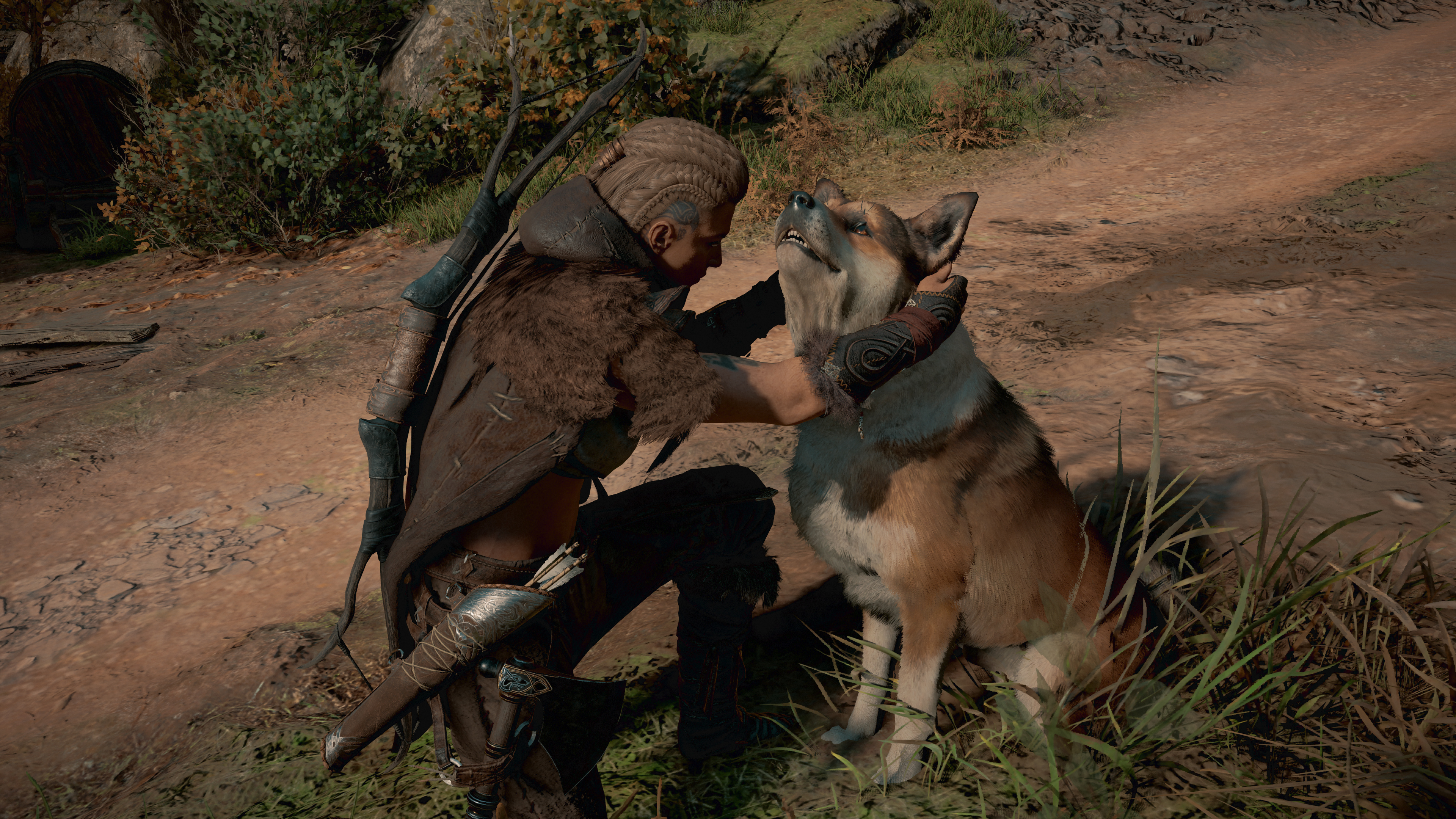
I spent hours climbing the vast snowy mountain tops of Norway in search of treasure, side quests and good ol’ iron ore. I only got to the title card after 8-plus hours because I was so lost in exploring Norway. The exploration elements are broken up into three classifications: Wealth, Mysteries and Artifacts. Wealth is essentially treasure like armor or crafting materials, while Artifacts can be anything from new tattoo designs to treasure hoard maps. Meanwhile, Mysteries are essentially sidequests, but Ubisoft took a vastly different approach to these.
They’re not fetch quests nor are they tedious grunt work. It’s hard to even call them quests because they don’t even show up in a log. They’re kind of just there and you have to figure out how to complete them. At first, the ambiguity was rather off-putting, but after getting a feel for them, these quests are far more immersive than what you find in most games.
An example of a mystery is finding a drengr (warrior) who has lost their clan and wishes to be sent to Valhalla by means of a duel with you. This is a pretty cool quest, but unfortunately, it has none of the flair that a samurai duel has in Ghost of Tsushima. It’s not fair to compare the two, but when I accepted this one dude’s duel, he started wailing on me before the camera even left the conversation perspective, so I’m hella salty.
The greatest incentive to explore is to obtain Books of Knowledge, which are classified as Wealth. Each book gives you access to a new ability similar to the abilities you get from your skill tree, except these are equipable and can be activated using an adrenaline point.
The reason why it’s so easy to traverse everywhere is because you can climb almost anything in Breath of the Wild style, with no restrictions on stamina. Of course, this is amazing for getting around, but being able to climb everything poses its own problems. Sometimes, Valhalla has no idea where I want to go. So if I’m chasing a target or even a collectible paper flying through the air, sometimes I’ll get stuck climbing up or down something instead of going straight. This has been a problem in older Assassin’s Creed games, but the issue has only gotten worse now that almost everything is climbable. It’s also nearly impossible to jump off of something you're climbing and onto something else because the game assumes you’re going in the direction your stick is pointing near as opposed to away from the structure.
Despite the occasional frustrating ails of climbing, one of my favorite things to experience while exploring is the music. The Viking-themed soundtrack is very reminiscent of the music in The Witcher 3. The intense drum beats and melodic vocals really sucked me into what I was doing, which is mostly just exploring or bashing faces in, but I love it. There’s a setting that lets you control how often exploration music plays. I set it to High, yet I noticed there were quite a few long stretches where music wasn’t playing.
If you’re going for the super immersive playthrough, you can set the Exploration difficulty to Pathfinder, which essentially turns off the icon distance indicator and the ability for close opportunities to show up on your map. Typically, I’m all for immersion, but I chose the Adventurer difficulty (the easiest), mostly because I don’t want to have to go out of my way to register things on my map. If you want to collect everything, I recommend just playing on Adventurer. Regardless of what you pick, however, icons on the map will still be unlabeled when you hover over them. I found this a bit odd. You can find out what they are by pulling up the legend, but that’s too much work for this particularly lazy gamer. What’s frustrating is that almost none of the vendors or buildings are actually labeled on the map.
Gorgeous world design vs. Dated character models
Ubisoft has consistently been behind on updating its character models to something that doesn’t look last-gen. Unfortunately, vibrant snowy peaks and lush green pastures can’t distract from characters with uncanny valley faces.
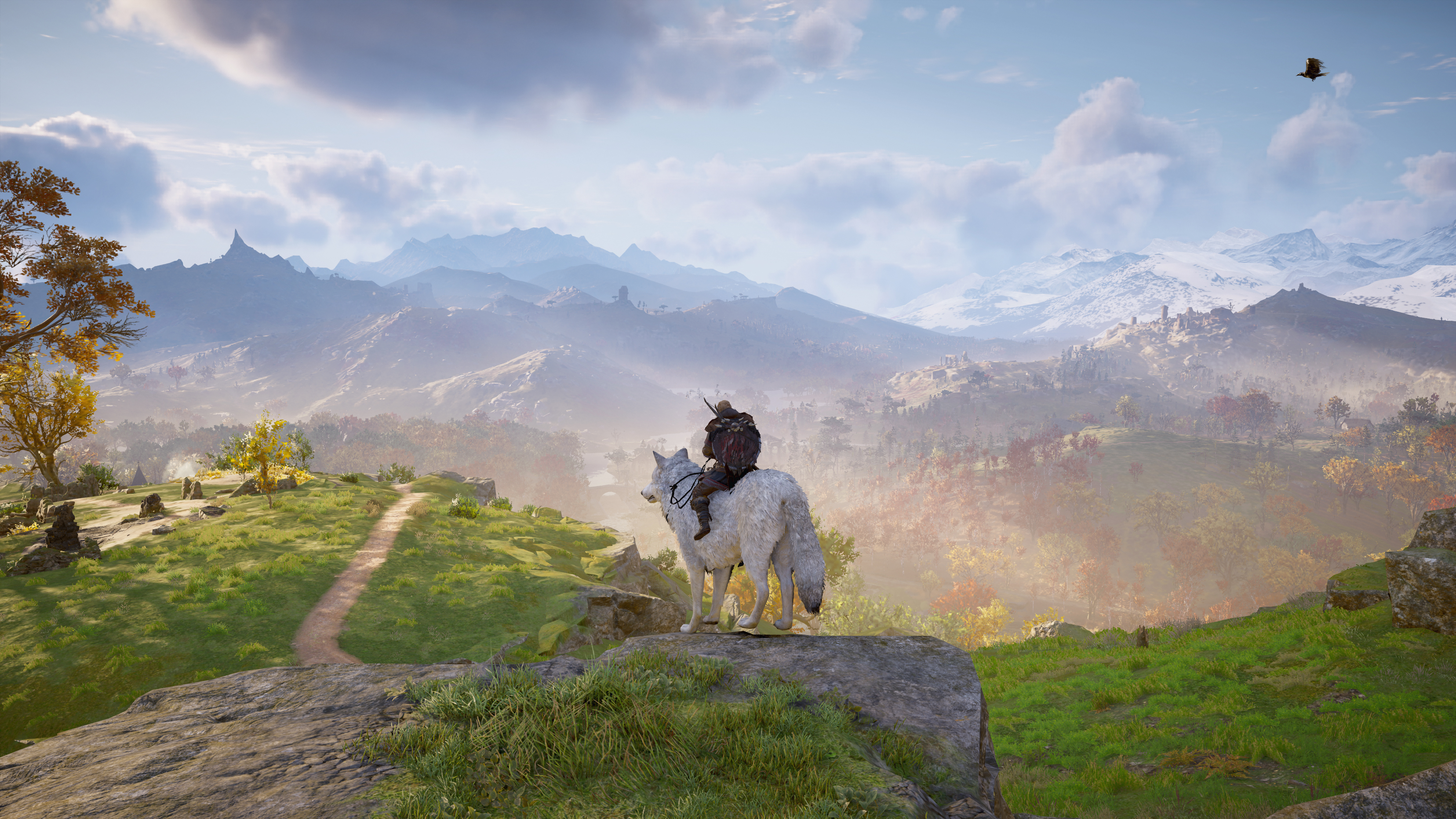
Ubisoft once again proved itself to be a master at world design. Norway and England are absolutely beautiful. The world is not only brought to life by its creative side-quests, but also its incredible detail in the terrain and unique enemy structures located around the world. I vividly remember scaling scaffolding across the side of a mountain to an enemy camp at the peak. The entire scenario was memorable because the scenery not only looked gorgeous, but it was constantly threatening to throw me into a bottomless chasm. Add the unique enemy placements above and below me, and you have a dodgy situation.
I’m also stunned by how huge these worlds are. When climbing up to a synchronization point, I’m stunned every time the camera pans around me, showcasing the vibrant landscapes and far-off structures. I’m truly impressed with the level of world design.
However, Ubisoft once again stumbles with its character models. Every character model I’ve encountered, including Eivor’s, looks worse than models in some PS3 games, like Metal Gear Solid 4. A multi-million dollar company shouldn’t have this issue, especially when studios like Ninja Theory created more realistic character models in Hellblade: Senua's Sacrifice, which was technically an indie game at the time.
Animations don’t look great, either. They just look and feel so janky, and I’ve seen conversations where a character’s lips don’t even move. One of the more annoying things to look at are tattoos. They’re a relatively big part of the game (more on that later) and they look like nasty JPEGs on Eivor’s body. Ubisoft needs to step up its game for next-gen.
What makes Assassin’s Creed Valhalla unique
From afar, Assassin’s Creed Valhalla looks like any other action-adventure role-playing game currently out there, so why play this over games like God of War or Ghost of Tsushima? Well, apart from continuing the Assassin’s Creed storyline (not enough incentive for me, so I don’t blame you), Valhalla introduces the mechanic of building out your settlement and contians a more in-depth assassination list.
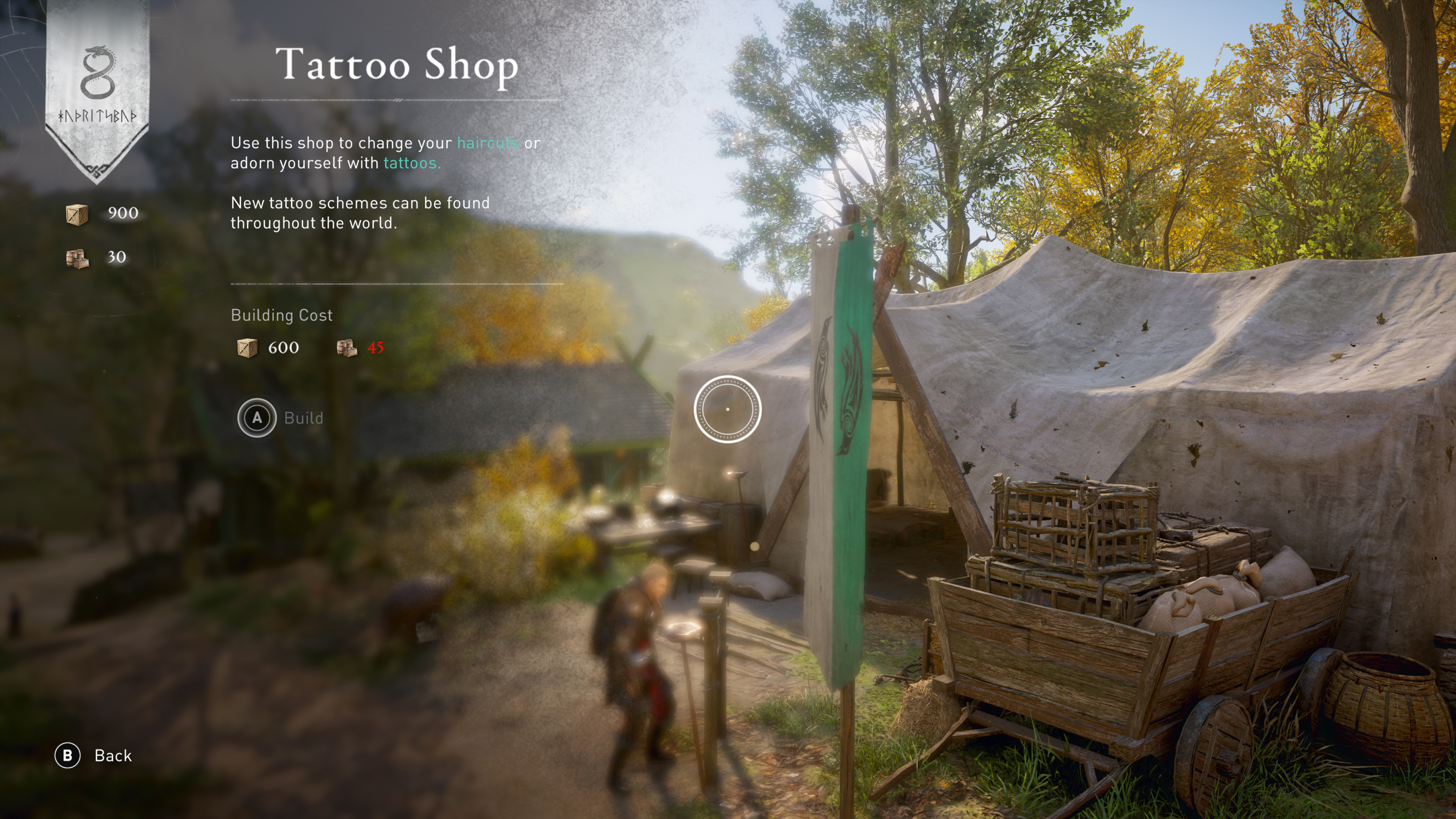
Firstly, building out your settlement is fun. It’s not very in-depth or creative, but it gives you incentive to go out on raids, which is where you can steal supplies and raw materials in order to upgrade and build structures. Some buildings include the Blacksmith (upgrades gear), Stable (upgrades mount and bird), Fishing Hut (unlocks fishing line and rewards you with fish), Hunter’s Hut (unlocks quests to hunt legendary animals), Tattoo Shop (customize tattoos and haircuts) and the Trading Post (purchase resources and unique items). Once your settlement expands, you can host feasts, which’ll net you a timed buff. You can also customize your settlement with a variety of sculptures and decorations. So far, I put up a huge statue of Odin and turned our giant tree into a Sage tree (that was the default anyway, but I made the choice, damn it).
Another building you can construct right away is the Assassin Bureau, which is where you get your list of targets and access to the Order tab in your menu. In the original Assassin’s Creed games, there was a linear quest-line to follow to assassinate targets, but this game actually gives you an assasination board with lists of known and unknown targets. Your goal is to kill the ones you know about and collect clues on the rest to find out who and where they are. The act of assassinating someone is rather simple, however, as it simply ends up being a person walking around a camp or the general overworld.
I like having some semblance of control over the target list, as opposed to previous games. And hopefully the targets at the bottom of the list (most important, in this case) are handcrafted to be more challenging to take out. There are memorable assassination missions in the previous games, because there were certain things you had to do in order to even get near the target. I hope it’s not all as easy as running up to an enemy and shanking them.
Assassin’s Creed Valhalla PC performance
Ubisoft has earned a poor reputation for releasing games packed with tons of bugs, but I think after Unity, the studio learned its lesson. I didn’t encounter many game-breaking bugs in Assassin’s Creed Valhalla, but there were a few frustrating moments.
The most prevalent bug, which happened quite a few times, causes my character model to freeze for a few seconds and not move whatsoever. I’ve had moments where Eivor simply wouldn’t jump and instead slid down and off of a mountain to their death. I’ve seen bugged Wealth icons on enemies that I’ve already looted. One of the most annoying ones was when I was raiding and couldn’t bust open a door with my Viking partner because we were strangely out of sync. One of the more pleasant bugs I encountered was facing off against a Zealot enemy; they were frozen and so I took the opportunity to get an easy kill on them (muhah).
I wouldn’t necessarily call it a bug per se, but the autosave is completely unreliable. It doesn’t save when I need it to, like before a combat scenario or after you loot something, so it has thrown me pretty far back. My biggest recommendation is to always save manually and don’t rely on autosaves.
When diving into the graphics settings, I found a decent variety of settings. In the Screen tab, there are settings for the field of view, fps limit, aspect ratio, resolution, refresh rate, VSync and resolution scale. Within the Image Calibration section of the Screen tab, you can adjust brightness, contrast, enable/disable HDR and adjust maximum luminance and exposure.
The Graphics tab features all of the advanced settings, including settings for the overall graphics quality, adaptive quality, anti-aliasing, world details, clutter, shadows, volumetric clouds, water, screen space reflections, environment textures, character textures, depth of field and motion blur.
Meanwhile, within the Interface tab, you can enable or disable each and every HUD element in the game. For a more immersive experience, I disabled Mini Quest Log and Fight Damage Numbers. The real issue with the HUD in this game is that most of the elements stay on screen all of the time, as opposed to disappearing when they’re not being used.
Unfortunately, there isn’t a dedicated accessibility menu, but there are some settings you can tinker with. There’s menu narration where you customize the sound of the voice, the pace and the volume. You can customize the size, color and backgrounds of the subtitles. You can turn on collision sound, so an additional sound will be played if your character can’t move forward if they’re stuck on something. There are settings for the general text size and in-game icon size. There are also aim assist settings, adjustable quick time event inputs and even a setting for guaranteed assassinations. In the Image Calibration section, you’ll find the colorblind settings.
I also really like that there are three different types of difficulty settings for Valhalla. There’s one for the Combat, Stealth and Exploration. I like that I can crank the Stealth difficulty down if I’m having trouble -- I won’t, but I like that I can anyway. I’m playing on Very Hard by the way. (I’m not bragging or compensating, I swear).
Assassin’s Creed Valhalla PC benchmarks and requirements
I ran my desktop-level Nvidia GeForce GTX 1070 GPU with 8GB of VRAM through Assassin’s Creed Valhalla’s benchmark on Ultra High settings at 1440p and got a modest 39 frames per second. Turning everything down to Low at 1440p, my GPU averaged 59 fps. You’ll definitely get over 60 fps if you go with 1080p.
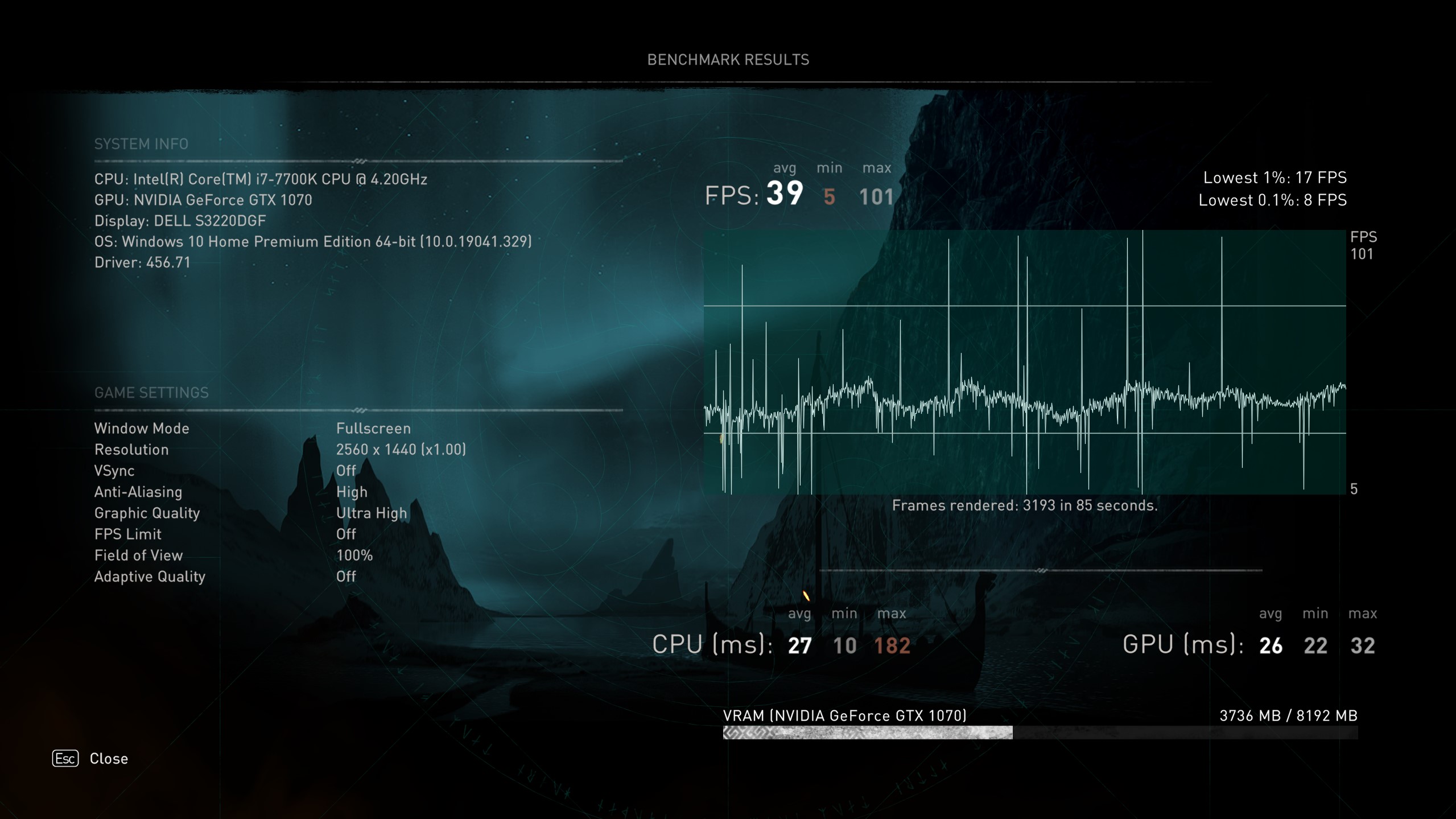
If you have a PC with a GPU that’s a couple of generations behind, like mine, we recommend playing Assassin’s Creed Valhalla on either a PS5 or Xbox Series X as you’ll benefit from super fast load times and more detailed graphics. If you purchase the game on the Xbox One and PS4 now for $59.99, you’ll be upgraded for free to next-gen consoles.
The minimum requirements for a system to run Assassin’s Creed Valhalla includes an Intel Core i5-4460 or AMD Ryzen 3 1200 CPU, an Nvidia GeForce GTX 960 or AMD Radeon R9 380 GPU and 8GB of RAM.
Meanwhile, the recommended specs (High, 1080p, 60 fps) require an Intel Core i7-6700 or AMD Ryzen 7 1700 CPU, an Nvidia GeForce GTX 1080 or AMD Vega 64 and 8GB of RAM.
If you’re looking to go all-out at 4K Ultra settings at 30 fps, Ubisoft recommends an Intel Core i7-9700K or AMD Ryzen 7 3700X CPU, an Nvidia GeForce RTX 2080 GPU and 16GB of RAM.
Bottom line
It was tough deciding on a score for Assassin’s Creed Valhalla. I really like this game and I’m excited to finish it all the way through, but it has one too many issues that I simply can’t ignore.
Ubisoft is getting somewhere, but it needs to dive deep and understand what makes these games fun and worth a player’s time. No developer will know what’s wrong with its games better than the developer itself. Ubisoft just needs to commit to stamping out avoidable issues like dated character models and janky mechanics.
Regardless, if you’re a big fan of Assassin’s Creed games, you’ll likely be satisfied with this latest installment. Even when comparing Assassin’s Creed Valhalla to the best action-adventure RPGs around, Valhalla went above and beyond with its exploration and world design.

Rami Tabari is the Reviews Editor for Laptop Mag. He reviews every shape and form of a laptop as well as all sorts of cool tech. You can find him sitting at his desk surrounded by a hoarder's dream of laptops, and when he navigates his way out to civilization, you can catch him watching really bad anime or playing some kind of painfully difficult game. He’s the best at every game and he just doesn’t lose. That’s why you’ll occasionally catch his byline attached to the latest Souls-like challenge.
